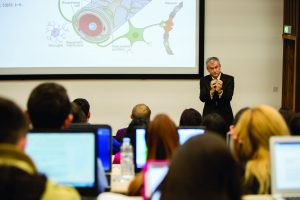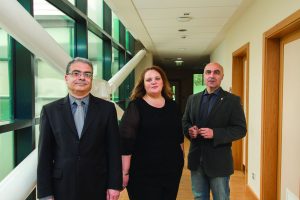An institution comprises a group of individuals who conglomerate to work towards a common goal. The University of Malta has come a long way. Cassi Camilleri speaks to past University of Malta Academic Staff Association presidents Prof. Ing. Victor Buttiġieġ and Prof. Matthew Montebello as well as support staff representative on Council Stephanie Abood.
T
he University of Malta (UoM) is a complex organisation, home to 14 faculties, 114 departments, and countless institutes and centres. However, while its makeup may be unique, it still abides by the old adage that an organisation is only as good as its people.
Working conditions at the UoM, for both academics and support staff, have been the subject of many colourful debates over the last twenty years, fuelled by blazing headlines that have appalled readers. Prof. Victor Buttiġieġ (President of University of Malta Academic Staff Association (UMASA) between 2001 and 2009) recalls his earlier years at the UoM when lecturers needed to fork out their own money to buy the supplies they needed to teach their students. And while some might shrug at that notion, it must be pointed out that this came around 1994 when the institution was in financial difficulties.
 That particular low point in the history of the UoM is now thankfully a long way off in its rear view mirror. Since then, positive changes have been made for the benefit of academic and support staff. Two game-changing collective agreements have been signed by UMASA Presidents Buttiġieġ and Prof. Matthew Montebello, and pushed forward by the outgoing rector, Prof. Juanito Camilleri. One agreement provided academics with sorely-needed salary rises and established the necessary structures to promote research. The support staff collective agreement introduced a number of relevant structures, including the introduction of study leave that has provided the opportunity for them to follow degree courses, as well as to receive scholarships and to have flexible working hours.
That particular low point in the history of the UoM is now thankfully a long way off in its rear view mirror. Since then, positive changes have been made for the benefit of academic and support staff. Two game-changing collective agreements have been signed by UMASA Presidents Buttiġieġ and Prof. Matthew Montebello, and pushed forward by the outgoing rector, Prof. Juanito Camilleri. One agreement provided academics with sorely-needed salary rises and established the necessary structures to promote research. The support staff collective agreement introduced a number of relevant structures, including the introduction of study leave that has provided the opportunity for them to follow degree courses, as well as to receive scholarships and to have flexible working hours.
A RUDE AWAKENING
The early 1990s proved to be a challenging time for the UoM. The selection of programmes available for study was limited, as were the resources at hand. Frameworks and organisational structures to promote positive change were close to non-existent. But Malta’s European Union membership changed things.
With the EU came an influx of opportunities, but also the burden of comparison. Immediately clear was the fact that the UoM could not compete with its foreign counterparts. Many used their newfound mobility within Europe to look for greener pastures. ‘There was nothing keeping us here anymore,’ says Buttiġieg, ‘and many bought themselves a plane ticket; they took their chances’.
Undoubtedly, this was a rude awakening to government officials. The ease with which professionals could leave meant Malta was facing a potential brain drain, a problem that continues to have real repercussions today. It was the Collective Agreement (CA) of 2009 which got the ball rolling to amend the situation. Camilleri suggested certain radical changes while UMASA and MUT provided their own proposals. Then negotiations began.
Academics’ salaries, at the time nothing short of paltry, were a big stumbling block in attracting and retaining academics, as many graduates and professionals were favouring private industry. Buttiġieġ’s aim was to see salary levels rise enough to compare with academics’ salaries in Europe. For lecturers to get another pay rise worked into the agreement, Camilleri had suggested that it would be justified if academics’ hours were extended, making them available from 8 a.m. to 8 p.m. This was the small step that led to big changes. ‘At that point, academics had the option to accept these conditions and get their raise or keep their original times.’ However, the money talk opened yet another can of worms. The Malta Union of Teachers (MUT) and UMASA locked horns when it came to the distinction between lecturers teaching at the G. F. Abela Junior College (an educational institution training students to enter the UoM) and those at the UoM, a distinction which previously did not exist, and which previously put lecturers from both institutions on equal footing.
This was a state of affairs which could no longer be accepted by UMASA for various reasons. Junior College lecturers required masters level qualifications to teach a MATSEC set syllabus (equivalent to the British ‘A’ level system). On the other hand, University academics were not only expected to run their own studies, but also to develop their own material, programmes, research, and so on. The issue was eventually resolved through an extensive exercise which saw the negotiating teams working out different career progressions for those teaching at Junior College.
Academics’ salaries, at the time nothing short of paltry, were a big stumbling block in attracting and retaining academics, as many graduates and professionals were favouring private industry.
Seeking to elevate the standards when it came to research, the 2009 CA also outlined the University’s procedures for research funding. ‘Getting funding for research was akin to a lottery,’ says Buttiġieġ, ‘You wouldn’t know when the next call for funding would be published.’ Today, the Project Support Office does great work in providing support and aiding researchers access the funds they need for their work.
Another important milestone which began with the 2009 CA was the setting up of its first Intellectual Property (IP) Policy, protecting the rights of researchers, students, systems engineers, technical staff, as well as private companies and the UoM as they strove to collaborate and innovate. This paved the way for the Knowledge Transfer Office and the innovation incubator TAKEOFF to be set up, initiatives which have led to new startups like the award-winning Thought3D, developers of 3D printing adhesive Magigoo. This is not to say that academics were happy with all the new changes. The Teaching Academic Effort (TAE) caused many disagreements. Touted as a new way of measuring teaching contribution, the TAE did away with the minimum number of lecturing hours as a ruler for output and replaced it with a complex system that ‘takes into account the number of students you have and tutorials you give, if you have assistants working with you [and so on]’. Buttiġieġ says ‘most people don’t like it. They don’t like to be measured.’ However, there is more to it than just a lack of enthusiasm for constant observation. In his view, the system is ‘bureaucratic rather than an effective method of quality control.’ Its saving grace is that it allows for comparison of activity across departments and it gives Heads of Departments a tool to show their need to hire more staff.
A more effective system for quality control with courses within University is the Programme Validation Committee (PVC) for which the recently elected rector designate, Prof. Alfred J. Vella, is Deputy Chairman. With help from the Academic Programmes Quality and Resources Unit (APQRU), programmes are audited and analysed to ensure that they reach an appropriate standard. Students’ input is also taken into consideration. All this ensures that optimal use is made of available resources.
Overall, the 2009 CA left academics at University feeling valued. ‘Most people were happy with the results,’ asserts Buttiġieġ. It also established a precedent and clearly communicated the fact that the UoM needed to work harder if it wanted to compete on the world stage. And this was a message that continued to be reinforced with the next CA, signed by Montebello in 2014.
BACK FROM The brink
Dealing with Junior College as well as Malta’s entry into the EU, brought about drastic changes for the 2009 CA. However, in 2014, there was still much potential for improvement for academics working at University. Spurred on by this mission, Montebello negotiated an agreement that put eLearning into focus.
‘We wanted people who develop eLearning programmes to be given promotions,’ says Montebello. And it’s not difficult to understand why. eLearning allows academics and students alike more flexibility in their work. It can also be used to entice a foreign student body. ‘We are already introducing some study units,’ says Montebello. ‘Eventually we hope to have a whole degree programme. If we have one full degree online, under- or postgraduate, this will generate income and will be a great step towards the University’s sustainability.’
One more step towards efficiency in University elections was the introduction of electronic voting for academics. There had been a major issue with elections at University prior to electronic voting. ‘You had faculty deans voted in solely by part-timers, meaning that the entire faculty board disapproved of the dean. There were instances in which deans would employ part-timers only to stay within their position of power and work funds as they saw fit.’ Weighted voting has done away with this issue, giving full time contributors to the University more of a say in the decision-making process and doing away with a damaging loophole. ‘This is a major achievement. The system is now more secure, more efficient, faster, and more representative of the academic body. People have faith in it.’
Quality assurance was another important aspect that Montebello homed in on. In the latest agreement, academics consented to provide an updated list of publications annually. Open research is very important to share publically funded knowledge. One such database is RefWorks, an online reference repository. ‘In this day and age, if you publish a paper you publish it online and share it with your peers,’ says Montebello. ‘However, at the moment there are professors, even young ones, who refuse to use these resources. And this just cannot be allowed.’ In the CA of 2014 academics are obliged to upload their publications on the system. This is a very good way of regulating quality. ‘If someone hasn’t published in five years, it will ring alarm bells.’ Montebello goes as far as to say that academics ‘who don’t publish anything in two years should be booted out of University. This is how we keep only the best people around,’ he asserts. At this point, the conditions were finally good enough to attract many foreign academics to teach and research at the UoM.
One of those people was Prof. Georgios N. Yannakakis (Acting Director, Institute of Digital Games). He saw the position Malta was in, with its limitations in resources and research, as a challenge. He saw Malta as a ‘country that wanted and still wants to invest in what I do’ and one that offers an ‘EU competitive salary’ as well as bonuses through EU grants. Of course, the public health and educational system as well as the Mediterranean lifestyle and Maltese culture, similar to that of his native Crete, did not hurt either. All in all, it was ‘a very attractive work/life package and I am very happy to have come here,’ says Yannakakis.
Another important milestone was the setting up of the first Intellectual Property Policy, protecting the rights of researchers, students, technicians, as well as private companies

Photo by www.ICreatemotionStudio.com
But academics are not the only ones making waves at the UoM. Administrative staff have effectively carved out their own position within the institution, asserting their integral role to its function, a role that had been undermined for years. Support staff representative on Council Stephanie Abood, who has been employed at University since 1989, has seen the evolution first-hand and continues to demand more.
‘Several positive changes have occurred over the last 10 years’, Abood says. Education is promoted consistently and support staff are encouraged to follow diploma and degree courses during their time at University. Study leave is now offered for a wider range of courses.
In a bid to make posts at the UoM more accessible to people in different circumstances, flexibility has been introduced. Working hours can be flexible. Teleworking is possible and study leave is available. These advances help push lifelong learning while maintaining the work/life balance, working parents benefit from better hours and conditions. All this has created ‘a win win situation,’ Abood says, especially with the new managerial grades.
Polishing and fine-tuning
Representatives Buttiġieġ, Montebello, and Abood, readily concede that the UoM has come a long way over the last decade. However, they also agree that they are by no means at the end of the road.
In relation to support staff, Abood says that there needs to be ‘more job rotation, with employees moving around and doing work related to their studies.’ Job satisfaction is key to people producing their best work.
In academia there is way to go when it comes to research. The UoM needs to continue giving research a more prominent role within its walls. Buttiġieġ expresses disappointment that the mechanisms created by the 2009 CA, specifically the opening of temporary posts for research, enabling professors to focus on their projects, were abandoned. ‘I don’t think that for the post of research fellows there was any sort of engagement. It seems to have fallen through. But as an idea it’s important. […] We need these mechanisms that allow people more flexibility and enable research. A university without research will be a normal post-secondary school.’
FUTURE PACTS
 The upcoming academic agreement in 2018 has a few tough bones it needs to tackle, including pensions and promotions. Retirement at University can mean a very significant cut in salary for academics. Their earnings have risen to the point that the cap has been reached and when government was approached to amend the situation during Montebello’s time as UMASA President, they were flatly refused. ‘The only people who get this pension level are members of parliament,’ he says, smiling. ‘I don’t think it will happen, realistically speaking, but it would be the next step in making University an attractive workplace for high-end professionals.’ Another alternative replacing a full pension is private pension schemes for academics. Their effect remains to be seen.
The upcoming academic agreement in 2018 has a few tough bones it needs to tackle, including pensions and promotions. Retirement at University can mean a very significant cut in salary for academics. Their earnings have risen to the point that the cap has been reached and when government was approached to amend the situation during Montebello’s time as UMASA President, they were flatly refused. ‘The only people who get this pension level are members of parliament,’ he says, smiling. ‘I don’t think it will happen, realistically speaking, but it would be the next step in making University an attractive workplace for high-end professionals.’ Another alternative replacing a full pension is private pension schemes for academics. Their effect remains to be seen.
Ideally, a contemporary university would provide high quality education to promising students who become valued members of its communities. It would also produce cutting edge research and would nurture new ideas that would keep it at the forefront of innovation, qualities that would make it relevant to the society it serves. To do all this, a university needs to attract and retain a workforce of talented professionals by providing appropriate working conditions. And therein lies the crux of the matter.
The future is a place of big possibilities for the UoM and its people. That much is clear. The question is: Will it rise to the challenge?






